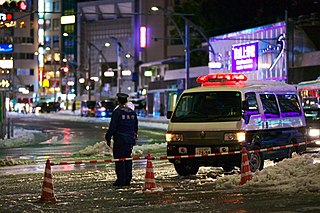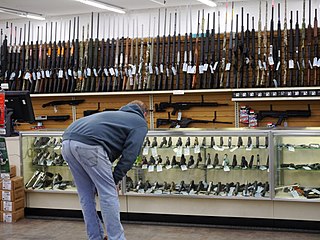Gun laws and policies, collectively referred to as firearms regulation or gun control, regulate the manufacture, sale, transfer, possession, modification, and use of small arms by civilians. Laws of some countries may afford civilians a right to keep and bear arms, and have more liberal gun laws than neighboring jurisdictions. Countries that regulate access to firearms will typically restrict access to certain categories of firearms and then restrict the categories of persons who may be granted a license for access to such firearms. There may be separate licenses for hunting, sport shooting, self-defense, collecting, and concealed carry, with different sets of requirements, permissions, and responsibilities.

Gun control, or firearms regulation, is the set of laws or policies that regulate the manufacture, sale, transfer, possession, modification, or use of firearms by civilians.

The right to keep and bear arms is a legal right for people to possess weapons (arms) for the preservation of life, liberty, and property. The purpose of gun rights is for self-defense, as well as hunting and sporting activities. Countries that guarantee the right to keep and bear arms include Albania, Czech Republic, Guatemala, Ukraine, Mexico, the United States, Yemen, and Switzerland.
Firearms in Canada are federally regulated through the Firearms Act and related provisions of the Criminal Code. Regulation is largely about licensing and registration of firearms, including air guns with a muzzle velocity of more than 500 ft/s or 150 m/s and muzzle energy greater than 4.2 ft⋅lb or 5.7 J.

Gun politics is defined in the United States by two primary opposing ideologies concerning the private ownership of firearms. Those who advocate for gun control support increasingly restrictive regulation of gun ownership; those who advocate for gun rights oppose increased restriction, or support the liberalization of gun ownership. These groups typically disagree on the interpretation of the text, history and tradition of the laws and judicial opinions concerning gun ownership in the United States and the meaning of the Second Amendment to the Constitution of the United States. American gun politics involves these groups' further disagreement concerning the role of firearms in public safety, the studied effects of ownership of firearms on public health and safety, and the role of guns in national and state crime.
Concealed carry, or carrying a concealed weapon (CCW), is the practice of carrying a weapon in public in a concealed manner, either on one's person or in close proximity. CCW is often practiced as a means of self-defense. Following the Supreme Court's NYSRPA v. Bruen (2022) decision, all states in the United States were required to allow for concealed carry of a handgun either permitlessly or with a permit, although the difficulty in obtaining a permit varies per jurisdiction.

Crime in Australia is managed by various law enforcement bodies, the federal and state-based criminal justice systems and state-based correctional services.

Law enforcement in Japan is provided mainly by prefectural police under the oversight of the National Police Agency. The National Police Agency is administered by the National Public Safety Commission, ensuring that Japan's police are an apolitical body and free of direct central government executive control. They are checked by an independent judiciary and monitored by a free and active press.
Crime has been recorded in the United States since its founding and has fluctuated significantly over time, with a sharp rise after 1900 and reaching a broad bulging peak between the 1970s and early 1990s. After 1992, crime rates have generally trended downwards each year, with the exceptions of a slight increase in property crimes in 2001 and increases in violent crimes in 2005-2006, 2014-2016 and 2020-2021. While official federal crime data beginning in 2021 has a wide margin of error due to the incomplete adoption of the National Incident-Based Reporting System by government agencies, federal data for 2020-2021 and limited data from select U.S. cities collected by the nonpartisan Council on Criminal Justice showed significantly elevated rates of homicide and motor vehicle theft in 2020-2022. Although overall crime rates have fallen far below the peak of crime seen in the United States during the late 1980s and early 1990s, the homicide rate in the U.S. has remained high, relative to other "high income"/developed nations, with eight major U.S. cities ranked among the 50 cities with the highest homicide rate in the world in 2022. The aggregate cost of crime in the United States is significant, with an estimated value of $4.9 trillion reported in 2021. Data from the first half of 2023, from government and private sector sources show that the murder rate has dropped, as much as 12% in as many as 90 cities across the United States. The drop in homicide rates is not uniform across the country however, with some cities such as Memphis, TN, showing an uptick in murder rates.

Gun violence is a term of political, economic and sociological interest referring to the tens of thousands of annual firearms-related deaths and injuries occurring in the United States. In 2022, up to 100 daily fatalities and hundreds of daily injuries were attributable to gun violence in the United States. In 2018, the most recent year for which data are available, the Centers for Disease Control and Prevention's (CDC) National Center for Health Statistics reported 38,390 deaths by firearm, of which 24,432 were suicides. The national rate of firearm deaths rose from 10.3 people for every 100,000 in 1999 to 11.9 people per 100,000 in 2018, equating to over 109 daily deaths. In 2010, there were 19,392 firearm-related suicides, and 11,078 firearm-related homicides in the U.S. In 2010, 358 murders were reported involving a rifle while 6,009 were reported involving a handgun; another 1,939 were reported with an unspecified type of firearm. In 2011, a total of 478,400 fatal and nonfatal violent crimes were committed with a firearm.

Gun-related violence is violence committed with the use of a firearm. Gun-related violence may or may not be considered criminal. Criminal violence includes homicide, assault with a deadly weapon, and suicide, or attempted suicide, depending on jurisdiction. Non-criminal violence includes accidental or unintentional injury and death. Also generally included in gun violence statistics are military or para-military activities.

This is a list of US states by gun deaths and rates of violence. In 2021, there were 26,000 gun suicides and 21,000 gun homicides, together making up a sixth of deaths from external causes. Gun deaths make up about half of all suicides, but over 80% of homicides.
Crime in Chicago has been tracked by the Chicago Police Department's Bureau of Records since the beginning of the 20th century. The city's overall crime rate, especially the violent crime rate, is higher than the US average. Gangs in Chicago have a role in the city's crime rate. The number of homicides in Chicago hit a 25-year high in 2021.

In 2018, the Small Arms Survey reported that there are over one billion small arms distributed globally, of which 857 million are in civilian hands. The survey stated that American civilians account for an estimated 393 million of the worldwide total of civilian held firearms, or about 120.5 firearms for every 100 American residents.

A mass shooting is a violent crime in which one or more attackers kill or injure multiple individuals simultaneously using a firearm. There is no widely accepted definition of "mass shooting" and different organizations tracking such incidents use different definitions. Definitions of mass shootings exclude warfare and sometimes exclude instances of gang violence, armed robberies, familicides and terrorism. The perpetrator of an ongoing mass shooting may be referred to as an active shooter.

The Public Safety and Recreational Firearms Use Protection Act, popularly known as the Federal Assault Weapons Ban, was a subsection of the Violent Crime Control and Law Enforcement Act of 1994, a United States federal law which included a prohibition on the manufacture for civilian use of certain semi-automatic firearms that were defined as assault weapons as well as certain ammunition magazines that were defined as large capacity.

Proposals for universal background checks would require almost all firearms transactions in the United States to be recorded and go through the National Instant Criminal Background Check System (NICS), closing what is sometimes called the private sale exemption. Universal background checks are not required by U.S. federal law, but at least 21 states and the District of Columbia currently require background checks for at least some private sales of firearms.
The National Firearms Agreement (NFA), also sometimes called the National Agreement on Firearms, the National Firearms Agreement and Buyback Program, or the Nationwide Agreement on Firearms, was an agreement concerning firearm control made by Australasian Police Ministers' Council (APMC) in 1996, in response to the Port Arthur massacre that killed 35 people. Four days after the killings, Australian Prime Minister John Howard told Parliament “We need to achieve a total prohibition on the ownership, possession, sale and importation of all automatic and semi-automatic weapons. That will be the essence of the proposal that will be put by the Commonwealth government at the meeting on Friday...". The APMC would agree to and form the NFA 12 days after the massacre on the 10th of May 1996.
Daniel W. Webster is an American health policy researcher and the distinguished research scholar of the Johns Hopkins Center for Gun Violence Solutions at Johns Hopkins Bloomberg School of Public Health. He is also the deputy director for research at the Johns Hopkins Center for the Prevention of Youth Violence, and the first Bloomberg Professor of American Health at the Johns Hopkins Bloomberg School of Public Health. In 2016, he became the director of the Johns Hopkins-Baltimore Collaborative for Violence Reduction, a joint crime-fighting effort between Johns Hopkins and the Baltimore Police Department.

Mass shootings are incidents involving multiple victims of firearm related violence. Definitions vary, with no single, broadly accepted definition. One definition is an act of public firearm violence—excluding gang killings, domestic violence, or terrorist acts sponsored by an organization—in which a shooter kills at least four victims. Using this definition, a 2016 study found that nearly one-third of the world's public mass shootings between 1966 and 2012 occurred in the United States, In 2017 The New York Times recorded the same total of mass shootings for that span of years. A 2023 report published in JAMA covering 2014 to 2022, found there had been 4,011 mass shootings in the US, most frequent around the southeastern U.S. and Illinois. This was true for mass shootings that were crime-violence, social-violence, and domestic violence-related. The highest rate was found in the District of Columbia, followed by Louisiana and Illinois.
















